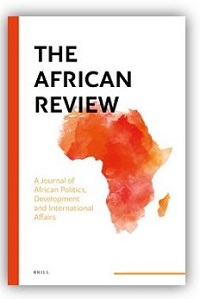An Analysis of Language Use in the Tanzania ' s 2010 Pre-election Newspaper Headlines in the Swahili Press
Abstract
The current paper undertakes a discourse analysis of the front page newspaper headlines of two Tanzanian Swahili weekly newspapers, Mzalendo (Patriot) and Mwanahalisi (Unfeigned child) during the 2010 preelection period with a view to showing how the press headline discourse in different ways constructs social identities and how these in turn act to influence readers ' voting decisions. The data used comes from ten issues of the two newspapers. The analysis is informed by the Faircloughian threedimensional framework incorporating: text, discursive practice, and social practice. The main finding is that the writers of both newspaper headlines used alike discursive methods such as selection of particular lexical items and syntactic manipulation with the intent of simultaneously vilifying the contestant viewed by the newspaper as the opponent while at the same time endorsing the one it was supporting. It is recommended that the public understands the strategies for them to make informed decisions.References
Chimombo, S. and Chimombo, M. 1996. The Culture of Democracy: Language, Literature. The Arts and Politics in Malawi, 1992-94. Zomba: WASI Publications.
Dor, D. 2003. "On Newspaper Headlines as Relevance Optimizers", Journal of Pragmatics, 35: 695-721.
Downing, A. and Locke, P. 2006. English Grammar A University Course. London: Routledge
Fairclough, N. 1995. Critical Discourse Analysis: the Critical Study of Language. New York: Longman Group Limited.
Høyer, S. 2005. "The Rise and Fall of the Scandinavian Party Press", in Høyer, S. and Pöttker, H. (eds.), Diffusion of the News Paradigm 18502000. Gothenburg: Nordicom.
Ifantidou, E. 2009. "Newspaper Headlines and Relevance: Ad hoc Concepts in Ad hoc Contexts", Journal of Pragmatics 41, 699-720.
Konde, H.1984. Press Freedom in Tanzania. Arusha: Eastern Africa Publications Limited.
Lindemann, B. 1990. "Cheap Thrills we Live by: Some Notes on the Poetics of Tabloid Headlines", Journal of Literacy Semantics 19, 46-59.
Moore, B.N. and Parker, R. 2001. Critical Thinking. Boston: McGraw-Hill.
Onyango, E. 2008. Three-Month Ban on Tanzanian Weekly Rattles Independent Media. http://buildingequipments.net/three-monthban-on-tanzanian-weekly (accessed 10October 2010).
Reah, D. 1998. The Language of Newspapers. London: Routledge.
Richardson, J.E. 2007. Analysing Newspapers: An Approach from Critical Discourse Analysis. New York: Palgrave Macmillan.
Shija W.A. 1990. The Role of Party Newspapers in Mobilizing the Masses in Tanzania: A Critical Analyis. http://archive.lib.msu.edu/DMC/African%20Journals/pdfs/africa%2 0media%20review/vol4no3/jamr004003002.pdf (accessed 11 December 2014).
Sbisà , M. 1999. "Ideology and Persuasive Presuppositions", in J. Verschueren (ed.) Language and Ideology: Selected Paper from the 6th International Pragmatic Conference, 1: 492-509. Antwerp: International Pragmatic Association.
Sturmer, M. 1998. The Media History of Tanzania. Ndanda: Ndanda Mission Press.
United Republic of Tanzania, Print Media: http://www.tanzania.go.tz/home/pages/1587 (accessed 11 December 2014).
United Republic of Tanzania, Newspapers: http://www.tanzania.go.tz/home/pages/1730 (accessed 11 December 2014).
Van Dijk, T.A. 1988. News as Discourse. New Jersey: Lawrence Erlbaum Associates.
Downloads
Published
Issue
Section
License
Copyright © by Department of Political Science and Public Administration, University of Dar es Salaam
All rights reserved. No part of this publication may be reproduced or transmitted in any form or by any means, electronic or mechanical, including photocopying, recording, or any information storage or retrieval system, without permission in writing from the publisher, except for short extracts in fair dealing, for research or private study, critical scholarly review or discourse with an acknowledgement.
The African Review: A Journal of African Politics, Development and International Affairs [ISSN 0856-0056 (Print) & ISSN 1821-889X (Online)] is published bi-annually, June and December by the Department of Political Science and Public Administration, University of Dar es Salaam, P.O. Box 35042 €“ Dar es Salaam €“ Tanzania



